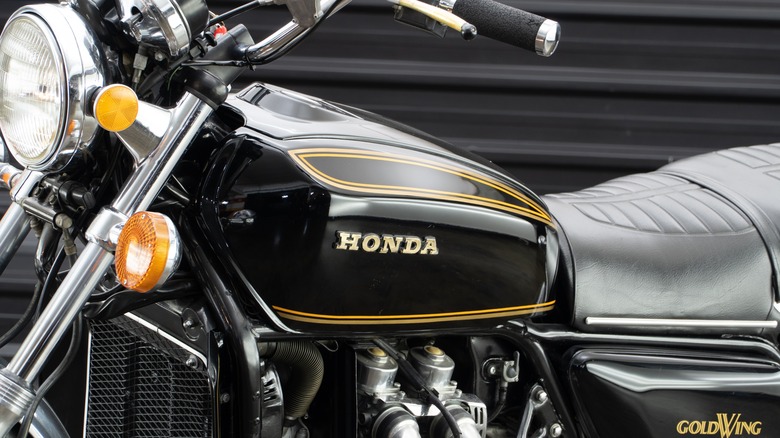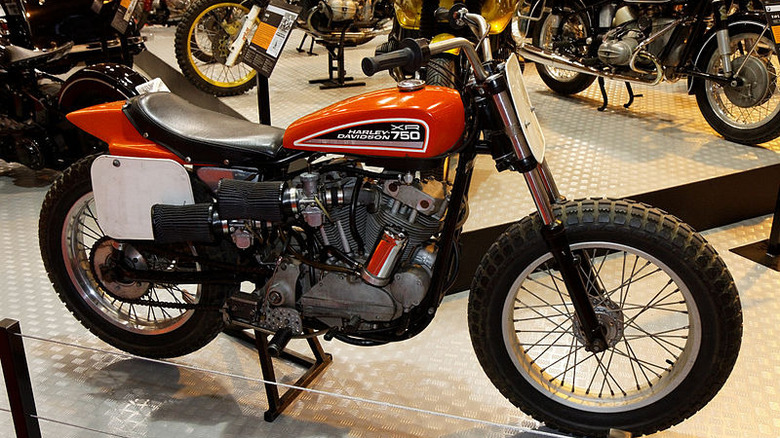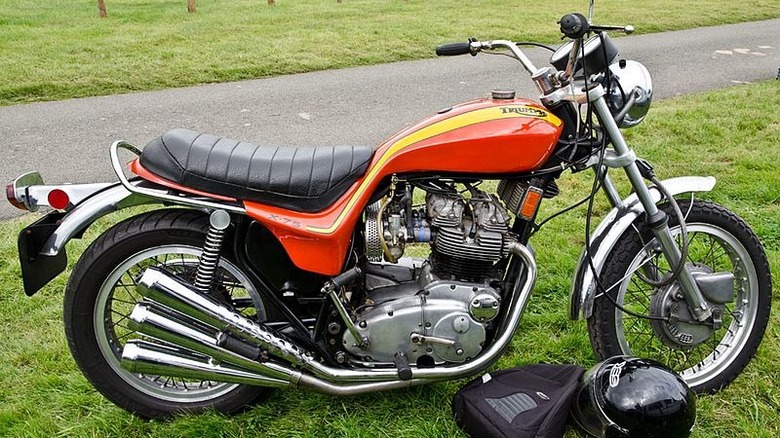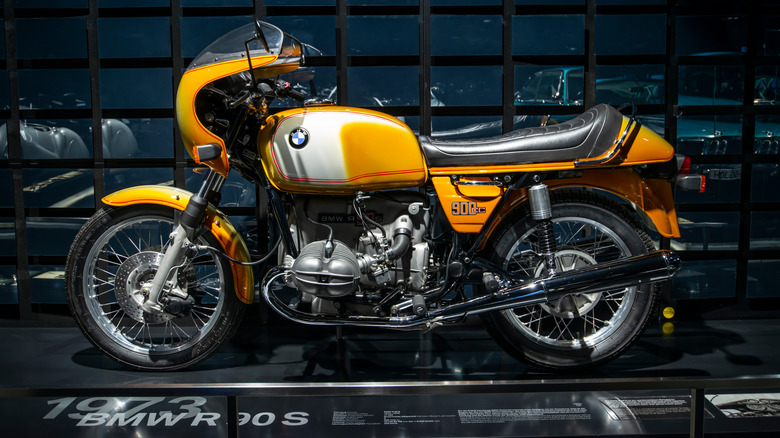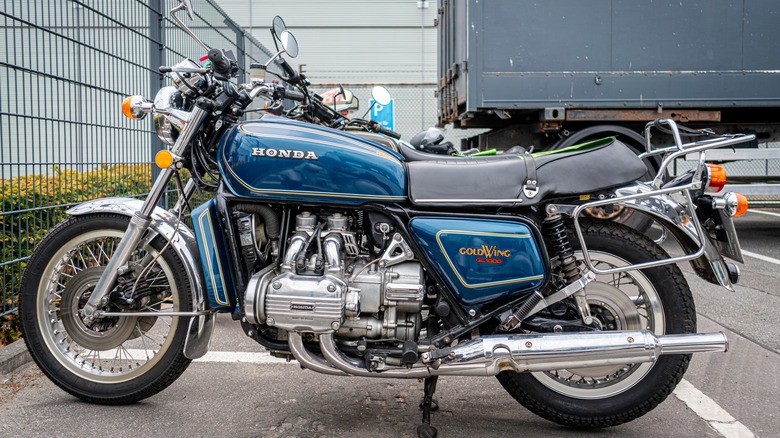5 Of The Most Iconic Motorcycles From The 1970s
From the "Houston, we have a problem" Apollo 13 mission, to the success of PONG and long lines at gas pumps, the 1970s was an age where disco reigned, Darth Vader choked, roller skating was big, the Vietnam War raged, and the Watergate Scandal upended politics. The '70s was a cacophonous decade full of colorful chaos. Amidst all that came some of the most exhilarating and industry-defining motorcycles ever made.
A driving force behind that was the OPEC oil embargo and the resulting energy crisis that led to the decline of beastly gas guzzlers. At the start of the decade, a gallon of gas cost a mere 36 cents. By 1979, it had gone to 86 cents; a year later, it would be $1.19.
The big four bike makers from Japan — Honda, Suzuki, Kawasaki, Yamaha — took advantage of this and began to rise in fame, while unceremoniously elbowing past old-guard international brands. This all occurred while pushing the industry as a whole into a fevered frenzy of building, bigger, badder, better rides, and proved the idiom that a rising tide does indeed lift all boats. Or, in this case, rising dune lift all motorcycles.
While a list like this is entirely subjective and could consist of dozens of examples, or even all from a single motorcycle maker, we'll take a more democratic approach. There are a broad swath from five different companies (and countries) that show each was integral to an era of motorcycles we likely will never experience again.
Husqvarna 400 Cross (1969)
Unless you're a die-hard motocross fan, you probably don't know that Husqvarna makes more than just chainsaws and lawnmowers. What may be even more shocking is that the Swedish company actually started off making guns way back in 1689. It made sewing machines, wood stoves, mincing machines, and bicycles before finally introducing its first motorcycles in 1903.
The Husqvarna 400 Cross was first produced in 1969 as an upgraded model to its 360 bike, complete with a fully-welded chromoly frame and a 400cc two-stroke engine. It immediately succeeded on off-road racing circuits, winning the 500cc World Championships in 1969 and 1970.
Enter "The King of Cool," Steve McQueen, who was notorious for his need for speed and loved racing cars and motorcycles. Throughout the 1960s, he was an avid fan of Triumph's heavy Desert Sled bikes. He became so enamored with Husqvarna's powerful two-stroke engines and lightweight bikes that he bought the very Viking 360 ridden by Swedish motocross champion Bengt Åberg.
In 1971, two things propelled the company to new heights in the United States. Bruce Brown's documentary "On Any Sunday" was released In July. It was about motorcycle racing and its stars, and included Steve McQueen riding around with them on Husqvarna's 400 Cross. It was such a hit that it was nominated for the Best Documentary Oscar the following year.
Then, in August, McQueen appeared on the cover of Sports Illustrated: shirtless, riding his Husky 400. Interestingly, that bike sold for $230,500 at a Bonhams auction in October 2018.
Harley-Davidson XR750 (1970)
The Average Joe American may not associate Harley-Davidson with dirt bikes, but between 1972 and 2008, the XR750 was specifically designed for dirt track racing. This Harley won 37 of 44 American Motorcyclist Association Grand National Championships and 502 premier-class event victories, making it not only the most successful in AMA history, but perhaps one of the most incredible bikes of all time.
The XR750 was equipped with a 750cc (45ci), air-cooled, 45-degree V-twin 4-stroke OHV engine inspired by the XLR Sportster that produced up to 82 horsepower. It was mated to a 4-speed transmission, weighed 295 pounds, and had a top speed of 115 mph.
However, most people in the '70s probably knew none of that, or didn't care. Instead, they saw it sitting underneath one of the era's greatest showmen, and we're not talking about Elvis Presley. We're talking about Robert Craig Knievel, aka Evel Knievel. Knievel used several bikes during his career, but in 1970, he brazenly walked into Harley's headquarters in Milwaukee, specifically looking for a sponsorship deal — and got it. During his prime, Knievel exclusively jumped a Harley XR750.
His stunts were televised globally on ABC's "Wide World of Sports," one of the most influential shows in history. Three of the top seven most-watched episodes were of Knievel jumping something, including the top spot. In October 1975, riding his trusty XR750, Knievel successfully leaped over 14 Greyhound buses at King's Island amusement park in Ohio, and set a new distance record of 180 feet.
[Image by Thesupermat via Wikimedia Commons | Cropped and scaled | CC BY-SA 3.0]
Triumph X-75 Hurricane (1973)
The wicked triple exhaust stack is the first thing your eye gravitates to when you look at this bike. Triumph has been pushing out motorcycles since 1902, and the British bikes are considered legendary. Many of Hollywood's biggest stars helped them reach that iconic status, from Marlon Brando to Steve McQueen. Evel Knievel infamously rode a Triumph Bonneville T120 when he failed to clear the fountains at Caesars Palace on New Year's Eve of 1967.
While badged as a Triumph, the X-75 Hurricane was ironically enough not British-made. When Triumph released the Trident and BSA Rocket 3 to the American market in late '68, the reception was, shall we say, not good. They were considered ugly ducklings and cost several hundred dollars more than Honda's CB750.
Don Brown, vice-chairman of BSA's American company, decided to go rogue and develop something that would appeal to American riders in secret. He paid custom bike builder and fairing fiberglass specialist Craig Vetter $12,000 to make the BSA Rocket 3 more appealing.
Vetter designed a sleek, blended single body that ran stem to stern. It was packed with a 741cc air-cooled, OHV inline triple that produced 58 horsepower, and had a top speed of 114 mph. Originally called the Vetter BSA Rocket 3, it was changed to the Triumph X-75 before going on sale. Only 1,172 were made of what many consider the first cruiser, and most certainly the industry's first factory custom bike.
[Image by SG2012 via Wikimedia Commons | Cropped and scaled | CC BY-SA 2.0]
BMW R90S (1973)
It's ironic that the iconic BMW, known for making cars, actually put out its first motorcycle a full five years before its first automobile — 1923 and 1928, respectively.
Before 1973, BMW Motorrad (the company's bike branch) was known for making bland, practical two-wheelers. In desperate need of a makeover, the division grabbed a man internally who was designing interiors for its cars. Hans Muth not only turned around the company's dying branch, but eventually became a legend within the industry, creating several more famous bikes for BMW — not to mention the Katana for Suzuki.
The heart of the R90S was basically a heavily reworked R75/5. However, it was a bike that became BMW's flagship and quite literally saved BMW motorcycles. Under the seat was an 898cc air-cooled, four-stroke, Boxer engine with Dell'Orto pumper carburetors and higher-compression pistons mated to a new BMW five-speed transmission. The engine kicked out 67 horsepower, with a top speed of 124 mph, while screeching over the quarter-mile in 13.5 seconds. It was also the first Beemer to get dual front disc brakes.
When it won the 1976 AMA Superbike Championship, a star was born, and went on to sell over 17,000 units. If the heart of the RS90 was the engine, its soul was the totally redesigned new look. The two-tone "Daytona Orange" paint scheme with red pinstriping on the RS90 is famous now, but you could only get Beemers in black before that. Muth choose that daring color merely to shake things up. Then there was the bikini fairing, the very first production-ready bike with one as a standard feature.
Honda GL1000 Gold Wing (1975)
When Honda first unveiled the GL1000 Gold Wing at the 1974 Cologne Show in Germany, it was dubbed "the ultimate motorcycle," meant to be a long-distance touring bike, whereas the popular CB750 was not. Most bikes from the '70s were built for speed and off-roading, but the Gold Wing went in the opposite direction. Honda wanted to compete with Harley, which more or less owned the "touring" market outright in the United States.
The first rather sporty GL1000 was equipped with a 999cc liquid-cooled horizontally-opposed flat-four engine producing 80 horsepower, with 63 pound-feet of torque at a top speed of 125 mph. It weighed a hefty 639 pounds (with fuel). It was a touring bike that could get up and boogey, which was all well and good, but it lacked any accouterments you'd expect to find on one — no reverse gear, radio, cruise control, or fairing.
But this supposed long hauler had several vital innovations. It was the first shaft-driven bike for the export market and the first liquid-cooled 4-stoke from a Japanese bike builder. The Gold Wing's single overhead camshafts (SOHC) were driven by rubber belts with teeth, a first for any motorcycle.
Today, the Gold Wing is much different. Aside from the 1833cc liquid-cooled horizontally opposed six-cylinder 4-stroke, it comes with all the bells and whistles you could ever want. It also weighs in at a robust 804 pounds. The original Gold Wing changed the face of touring bikes globally and rightfully deserves a place on the list.
